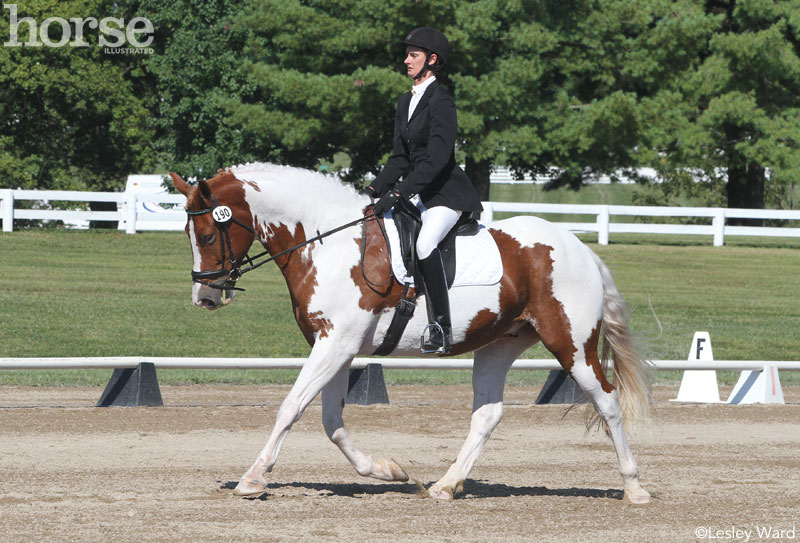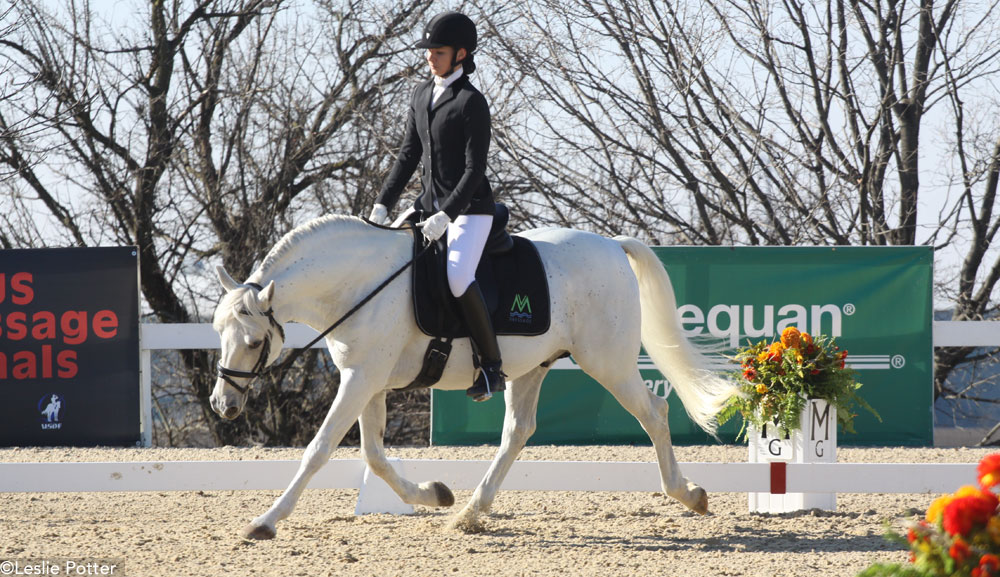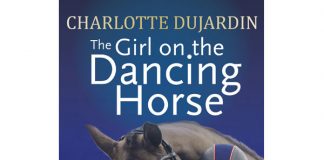Working gaits? Check! Rhythm and regularity? Check! 20-meter circles? Check! Whether you’re bringing along a green horse or just getting started in dressage, Training Level is your starting point.

The First 45 Seconds
Once you have the go-ahead from the ring steward, you may ride around the exterior perimeter of the arena before your test begins. The judge and scribe are often busy at this point completing the paperwork from the previous ride. Once the judge is ready, the bell will ring and you have 45 seconds to enter the arena and begin your test.
This is your moment to set your horse up for a great test. “Use the trip around the arena to get the horse used to the environment,” says U.S. Dressage Federation (USDF) gold medalist and leading sport horse breeder Ken Borden. “A lot of times, the horse never sees the judge until he is in the ring, so you always want to show the horse the judge’s box with both eyes; approach it from both directions. As you pass by, say hello and tell the scribe your number.” Your horse will often relax when he hears the judge or scribe reply from the booth.
This is also your chance to present yourself and your horse as professionally as possible. “Don’t try to fix problems outside of the arena and show the judge your problem zones,” cautions Borden. Ride positively, making good use of your time. Once the bell rings, use your full 45 seconds, entering with a long, straight approach toward the judge.
Likewise, when you exit, remember that you are leaving your final impression. “After you have saluted, the judge still has four scores to give [the collective marks],” says Borden. “When you are done, leave on a free rein. Pat your horse and thank the judge.”
From the Judge’s Box:
Be ready to go on time, says U.S. Equestrian Federation (USEF) “S” dressage judge Debbie Rodriguez. The time that you are assigned is the time the judge could signal for you to start, not the time you arrive to trot around the arena. Check in with the steward to see if your ring is running on time or not, and adjust your warm-up accordingly.
Once the rider ahead of you has saluted and begun to exit, you may make your way around the outside of the arena. Know whether your arena’s signal is a bell or whistle if there are other rings going nearby.
“When the bell is rung, head toward the entrance at A,” says Rodriguez. “Enter on your horse’s best side if possible, so he’s connected and active coming down the centerline.”
The Free Walk
The free walk isn’t a chance to take a break. In fact, at Training Level it’s scored with a coefficient of 2, meaning that your mark is doubled.
To make the most of this gait, you need to stay alert, even if it seems like you don’t have to. “I rarely see a free walk bold and forward enough,” says Borden. “I generally see a lazy, conservative free walk with little overstep and little stretch.”
To set your horse up for a dynamic free walk, Borden recommends first creating more energy before the corner; this will encourage your horse to seek the bit and stretch into the contact when he’s released on the diagonal. “Preparation is crucial; it makes the horse want to push to the hand,” notes Borden. “Keep the same bend from the corner throughout the entire diagonal. Often the horse starts to come back up at X; be sure to ride all the way across the diagonal to the letter. Gather the reins after the second quarterline with the inside rein first so that you can bend to keep the horse relaxed. Don’t be in a rush to gather him back up. You have the whole corner to get organized.”
From the Judge’s Box:
Why is this movement so important? “Free walk is where we see the true quality of the gait,” explains Rodriguez. “It shows if the horse is correctly working over his back by how willing he is to stretch into a round, swinging frame when the rein is lengthened.”
“We’re looking first for a four-beat walk, then that the horse swings through his back and reaches freely through his shoulders,” continues Rodriguez. “The horse should stretch to the bit as the rider gives the reins, and stay in a relaxed, even rhythm.” She adds that higher scores go to horses that are active, overtracking and swinging over the back.
When given the reins, your horse should willingly and politely take them. This means no grabbing the reins, looking around or changing tempo. In addition, at Training Level, the transition to medium walk is factored into the free walk score. “We want to see that the horse willingly lets the rider take up the reins and comes back into a supple connection, keeping the same rhythm and swing,” says Rodriguez.

The Stretchy Circle
The stretchy circle is a 20-meter circle at the rising trot. Your horse should stretch forward and downward while seeking the contact and gradually taking the reins as you invite him into a longer and lower frame. This is another movement that’s scored with a coefficient of 2.
“Rhythm is first and foremost,” says Borden. “Stretching forward and downward is second. Third is maintaining that light contact as the horse stretches. He should keep balance, rhythm, tempo and quality of gait. Deeper and unbalanced is not as good as balanced with adequate stretch.”
To achieve this, Borden counsels riders to take it slow and steady. “It doesn’t have to happen right away when you leave the wall,” he says. “I generally don’t have my stretch until the [first] quarterline. At the end, gradually take the horse back up. I generally don’t start to take up the reins until the quarterline before the rail, and I don’t have reins all the way up until I’m back on the track. Before you take the horse up, you almost want a small moment of acceleration. Going slower when you take up the reins causes tension, like using the brake and gas pedal at the same time. Think forward.”
Borden points out that most horses get slower as they reach down, while a few get hurried. For a horse that rushes, he recommends establishing more bend with the inside rein and leg. For a lazy horse, leg-yield a bit outward toward the outside rein, which causes the horse to push more from the inside leg. Both techniques create more bend in the body, rather than in the neck, keeping the contact in the outside rein.
From the Judge’s Box:
“Number one, we want to see that the horse stays in an active working trot with a good tempo,” says Rodriguez. “Some horses quicken, and some horses slow down. The horse should willingly stretch as much as the rider gives the rein without pulling, going both outward and downward with the stretch. We want submission as the horse is given the rein and as the rein is taken. Most often, we see the quality of the trot improve with the stretchy trot. The horse will swing through his back more and relax more. There’s no advantage to your horse going down to the absolute lowest point with his nose almost on the ground, as that defeats the purpose of developing a round topline.”
Rodriguez adds that you can still steer and half-halt in the stretchy trot. To make sure you have this ability, only give as much rein as your horse will take; continue to steer with your seat and reins. Make sure your circle stays a circle; if it isn’t round, it can upset your horse’s tempo and balance.
Centerline and Halt
Twice in your test, you head down the centerline to halt at X, making your first and last impression. This is a good spot for riders without fancy movers to rack up some points. “The halt and centerline are easy scores for average movers,” says Borden. “Maintain your halt for five seconds. Remember that the judge at C can’t really see the hind legs, so don’t try to fix too much. Sit square and still with relaxed hands.”
Borden recommends practicing your straight line and transitions into and out of the halt at different places in the arena. You also want to take advantage of the opportunity at Training Level to walk into your halt, which allows you to create a transition that pushes from behind. Begin preparing in advance for your halt in order to avoid an abrupt transition.
From the Judge’s Box:
Judges are looking for straightness from your entrance into the arena through your halt and all the way up to your turn at C, says Rodriguez. She often sees riders look left or right as they approach X, which can cause the horse to drift. Let your peripheral vision guide you to X. Also, many riders swing wide as they turn at C and again for the final turn onto the centerline at A. Practice straightness at home; anyone can give you feedback as to whether you are staying on the centerline.
Along with straightness, Rodriguez says your horse should maintain his balance and not fall on his forehand or come above the bit in the trot-halt-trot transition. “You should have the same balance and connection in the halt that you have in the working trot,” she explains. “At Training Level, you can have a walk step or two, but a more direct transition has a higher score.”
Better Basics
Approach all of your schooling and showing with the basics first and foremost. “Focus on the training scale,” says Borden. “Keep rhythm and balance. Ride steady and forward with no tension.
Basics should be more important to riders than just requirements of the test itself.” He distills this idea for Training Level horses into three B’s: “Balance of the horse (forward and in front of your leg), bend (I always have a bent horse; I think too many people ride a stiff, straight horse at the lower levels), and brilliance (go for the pizzazz.)
“I think there’s not enough brilliance overall at the lower levels,” adds Borden. “Ride freely forward. Forward is a direction, not a speed, but people focus too much on controlling their horse, so it often feels to them like they’re out of control or the stride is lengthening, when the horse is actually expressing himself.”
Borden also cautions riders to pay attention to the integrity of their rein contact. “I find most amateur riders are holding on to both reins too tightly,” he explains. “I always have one rein that’s soft and one rein that’s more active: My inside rein is frequently soft, and my outside rein is frequently tighter. We have to create a tunnel for the horse to go through, but that tunnel has to have openings and freedom. The freedom is through the reins, or else the horse has blocked forward energy. At the lower levels, riders often hang on both reins the same amount. The energy gets blocked because of the rider’s hands.”
From the Judge’s Box:
“The horse with the better basics will always be on top,” says Rodriguez. “We’re looking for the rhythm, relaxation and suppleness at Training Level. The gaits need to be active, and the horse needs to be using the correct muscles.
“Sometimes at Training Level we see the rider is not confident enough with an active canter to keep it a clear three-beat gait. You want to ride confidently enough to keep the energy so the rhythm stays clear.”
Once you’ve got the basics down, you can use these pointers to help
pick up every possible point during your next Training Level test.
Meet the Experts
Kenneth Borden Jr: U.S. Dressage Federation (USDF) gold medalist Ken Borden has bred, trained, and sold horses for dressage, hunter/jumpers and eventing at his family’s Little Bit Farm in Wilmington, Ill., for nearly 30 years. Borden’s breeding and training program has produced countless USDF, U.S. Equestrian Federation (USEF) and U.S. Eventing Association horse of the year winners. Borden is also a USDF “L” graduate.
Debbie Rodriguez: USEF “S” dressage judge and USDF gold medalist Debbie Rodriguez of Williamsburg, Va., is an active instructor, clinician, judge, trainer and competitor through the Grand Prix level. She also carries a USEF “r” eventing judge license and previously served as technical delegate in eventing and dressage.
NATALIE DeFEE MENDIK is an award-winning freelance writer specializing in equine media. She lives in Pennsylvania with her husband and two daughters, where her horse passions include dressage and vaulting. www.mendikmedia.com
This article originally appeared in the March 2014 issue of Horse Illustrated magazine. Click here to subscribe!





